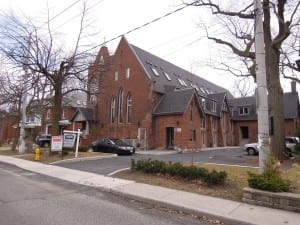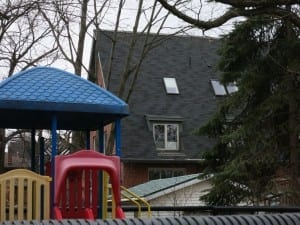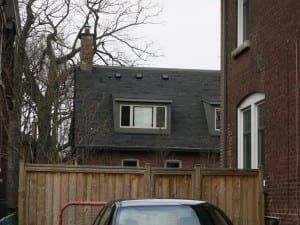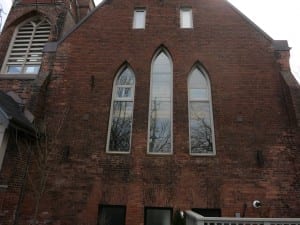21 Swanwick Avenue church-to-condo conversion, completed in 2009, is located at a site dating back to 1888
A City of Toronto By-Law was enacted on April 24, 2007 to designate 21 Swanwick as a heritage property under the Ontario Heritage Act. The bylaw notes that:
“Emmanuel Presbyterian Church is an institution that contributed to the historical evolution of the East Toronto community. The development of the site dates to 1888 when a small building was constructed following the merger of two Presbyterian congregations as Emmanuel Presbyterian Church. The present church was completed in 1893 under the direction of contractors McMillan and Costain. Alterations in 1901 and 1914 included an entrance porch and a large wing (for a church hall and Sunday School). With changes in local demographics, in 1973 Emmanuel Presbyterian Church joined with St. James Presbyterian and St. Matthew’s Presbyterian (both established in 1925) to create the Tri-Congregations, a three-point charge served by a team ministry. In 1988, the latter congregations amalgamated as Faith Presbyterian Church Community Church, now located in East York.”
Subsequent staff reports outline the conversion process
A May 30, 2008 staff report is entitled 21 Swanwick Avenue, Emmanuel Presbyterian Church, Approval of Alterations to a Heritage Property. The report notes that proposed alterations to the building, now known as The Swanwick Heritage Lofts, are acceptable in order to accommodate the new use for the church.
A June 12, 2008 staff report, entitled 21 Swanwick Avenue – OPA & Rezoning – Final Report, provides an overview of the building’s church-to-condo conversion, in Ward 32 – Beaches-East York. The report notes that concerns raised at a Community Consultation have been addressed.
Hackworth and Gullikson (2013)
An article by Jason Hackworth and Erin Gullikson, provides background regarding 21 Swanwick Avenue. [To access the article, click on link in previous sentence.]
The authors describe the 21 Swanwick Avenue church-to-condo conversion as an apt illustration of a “mixed form, secular function” redevelopment.
They note that the site, located on the south side of Swanwick Avenue, is surrounded on three sides by single-family detached housing. The entire church was preserved through redevelopment but also includes an addition. “The site,” the authors note, “was included on Toronto’s Inventory of Heritage Properties in 1984 for its Gothic Revival features. These include brickwork, square tower, gabled roof, and Arts and Crafts style porch and façade attributes.”
The story related to the church includes a request by the developer for a a demolition permit, which was denied by Toronto City Council in March 2007. The property was subsequently designated under Part IV of the Ontario Heritage Act.
The developer consequently entered into a Conservation Plan with Toronto Heritage Preservation Services to preserve the church’s masonry, some windows, and several staircases while converting the covered porch to an open walkway.
The developer subsequently converted the church into ten row houses, extended the southern part of the building, and added dormers in the church’s roof.
“Each unit contains obvious elements of the original church and the building still resembles a place of worship,” Hackworth and Gullikson note.
“Although most redevelopment took place within the existing building envelope, the addition to the church’s southern wing at a height greater than the site’s allowable 10 meters, and proposed residential density of 1.18 times the lot area, necessitated rezoning. Given that the Official Plan considers the area a neighbourhood, where the prevailing building type is single- detached housing, an amendment was required to allow development different from the neighbourhood’s existing structure (City of Toronto, 2007c).”
Reference
Hackworth, J. and E. Gullikson (2013). Giving new meaning to religious conversion: Churches, redevelopment, and secularization in Toronto.





Leave a Reply
Want to join the discussion?Feel free to contribute!